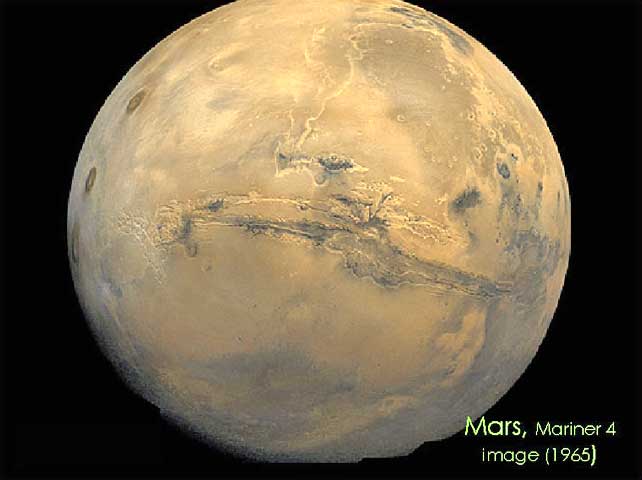|

by David Talbott
from
Thunderbolts Website
Mar 31, 2005

Credit: NASA/JPL
The astonishing landscape of the planet
Mars could force a reevaluation of all popular ideas about the
planet. Yet even its most “improbable” geology finds a unified
explanation in the electric discharge hypothesis.
From the first glimpses of the Martian surface, the planet revealed
one paradox after another. Images of Mars did not fit the textbook
picture of a cold and inactive rock ever-so-slowly peppered by
random impacts.
Planetary scientists responded by applying two assumptions, both of
them formulated long before the space age began and long before the
onrush of new evidence pointing to electricity’s influence on
galactic, stellar, and planetary evolution. They assumed that Mars
has moved on a stable orbit for billions of years. And they assumed
that present geologic processes on Earth are the key to
understanding Martian history.
Both assumptions must now be abandoned because new discoveries
contradict them. But it is unlikely that planetary scientists will
see the evidence until they stop projecting prior theoretical models
onto Mars and give adequate attention to the detailed images, now in
hand, that simply do not fit traditional preconceptions.
Another view of Mars is possible, and its contrast with popular
ideas about Mars could not be starker. The new vantage point arises
from a convergence of scientific and historical investigation. Two
individuals who have helped to lead the way in this are David Talbott and
Wallace Thornhill, co-authors of
Thunderbolts of the
Gods. Both were inspired decades ago by the work of
Immanuel Velikovsky, author of the 1950 bestseller
Worlds in Collision. Talbott was the founder and publisher of the ten-issue
groundbreaking series, “Immanuel Velikovsky Reconsidered,” in 1972.
He later authored a book, The Saturn Myth (Doubleday, 1980),
proposing a “catastrophist” approach to world mythology.
As early as the 1960s, Australian
physicist Thornhill, following the lead of Velikovsky (and later
Velikovsky’s close colleague Ralph Juergens), began a lifelong
investigation of electricity in the cosmos. Talbott and Thornhill
first met and talked for several hours at an international
conference on Velikovsky’s work in 1974. For years after that
meeting they pursued their investigations separately, each largely
unaware of the other’s work. Then, in 1997, they began a
collaborative approach in concert with many other contributors, some
of whom are included as editors of these pages.
The authors of Thunderbolts contend that an “intellectual tsunami
may be necessary to shake planetary science out of a decades-long
stupor”. For this purpose, Mars could be the best provocation,
since, according to Talbott and Thornhill, every square mile of Mars
shouts the same message:
From pole to pole, the surface of the
planet has been sculpted by electric discharge.
The picture above was returned by the Mariner 4 probe as it
approached Mars in 1965. It shows
Valles Marineris, a giant trench
more than 3000 miles in length. What event cut this monstrous chasm
on Mars? Planetary scientists first thought water erosion was the
agent, but that interpretation collapsed in the face of higher
resolution images. Now some speak of surface spreading and rifting.
But here, too, one need only examine pictures closely to exclude the
interpretation. The defining features show no surface spreading.
Detailed close-ups show that the force creating the chasm scooped
out and removed the material—a fact clearly evident along the neatly
machined “tributaries” all the way up to their rounded terminations.
The result of the event was a continental scale trench equivalent to
hundreds of Grand Canyons.
Every textbook on Mars will tell you that Olympus Mons, a giant
mound dwarfing Mount Everest, is a “shield volcano”. And no doubt
that interpretation seemed obvious when NASA scientists received the
first images of the towering formation. But again, the defining
features of Olympus Mons and its counterparts on the Tharsis bulge
cannot be found on shield volcanoes on Earth:
-
the shallow,
superimposed flat-bottomed calderas at the summit
-
the finely filamented “mane” of channels radiating from the summit
-
the steep
escarpment
-
the depressed terrain surrounding the escarpment
-
the
concentric ridges and valleys in the mysterious “aureole”...
—all are
diagnostic of a single phenomenon: an electric discharge impinging
on an anode, or positively charged surface. The fundamental
structure of Olympus Mons can be replicated in the laboratory.
Of course, the phrase “electric discharge” has yet to enter the
lexicon of Martian geology—or astronomy for that matter. Fundamental
shifts in theoretical perspective do not come quickly. But one
advantage of the electrical interpretation is that its implications
are both sweeping and testable. The electric theorists claim that
all of the primary patterns of Martian geography are replicable by
electric discharge. In contrast, they argue, close inspection of the
planet’s surface features will, in every significant case, refute
NASA’s contrived and often contradictory “explanations”.
In introducing the “planet of a thousand mysteries,” we have
discussed craters in the lab and cratering patterns on Mars, Martian
dust devils global dust storms on Mars,
Martian “Blueberries” in the
lab, analogs of these “concretions” on Earth, and—on a much larger
scale—analogous domed craters on Mars. But these few glimpses do not
begin to tell the larger story of the Red Planet. A unified portrait
of Mars is possible. Only a fundamental change in vantage point is
required.
|

